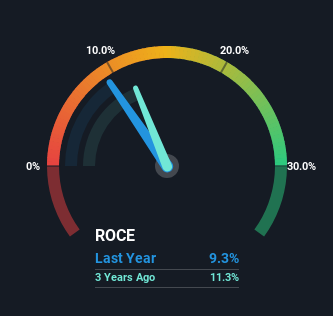To find a multi-bagger stock, what are the underlying trends we should look for in a business? One common approach is to try and find a company with returns on capital employed (ROCE) that are increasing, in conjunction with a growing amount of capital employed. Ultimately, this demonstrates that it’s a business that is reinvesting profits at increasing rates of return. Although, when we looked at Verizon Communications (NYSE:VZ), it didn’t seem to tick all of these boxes.
Return On Capital Employed (ROCE): What Is It?
Just to clarify if you’re unsure, ROCE is a metric for evaluating how much pre-tax income (in percentage terms) a company earns on the capital invested in its business. To calculate this metric for Verizon Communications, this is the formula:
Return on Capital Employed = Earnings Before Interest and Tax (EBIT) ÷ (Total Assets – Current Liabilities)
0.093 = US$30b ÷ (US$380b – US$53b) (Based on the trailing twelve months to December 2023).
Therefore, Verizon Communications has an ROCE of 9.3%. In absolute terms, that’s a low return, but it’s much better than the Telecom industry average of 5.6%.
See our latest analysis for Verizon Communications
Above you can see how the current ROCE for Verizon Communications compares to its prior returns on capital, but there’s only so much you can tell from the past. If you’d like, you can check out the forecasts from the analysts covering Verizon Communications for free.
How Are Returns Trending?
On the surface, the trend of ROCE at Verizon Communications doesn’t inspire confidence. Over the last five years, returns on capital have decreased to 9.3% from 13% five years ago. On the other hand, the company has been employing more capital without a corresponding improvement in sales in the last year, which could suggest these investments are longer term plays. It may take some time before the company starts to see any change in earnings from these investments.
The Bottom Line
In summary, Verizon Communications is reinvesting funds back into the business for growth but unfortunately it looks like sales haven’t increased much just yet. Unsurprisingly then, the total return to shareholders over the last five years has been flat. All in all, the inherent trends aren’t typical of multi-baggers, so if that’s what you’re after, we think you might have more luck elsewhere.
Like most companies, Verizon Communications does come with some risks, and we’ve found 5 warning signs that you should be aware of.
While Verizon Communications may not currently earn the highest returns, we’ve compiled a list of companies that currently earn more than 25% return on equity. Check out this free list here.
Have feedback on this article? Concerned about the content? Get in touch with us directly. Alternatively, email editorial-team (at) simplywallst.com.
This article by Simply Wall St is general in nature. We provide commentary based on historical data and analyst forecasts only using an unbiased methodology and our articles are not intended to be financial advice. It does not constitute a recommendation to buy or sell any stock, and does not take account of your objectives, or your financial situation. We aim to bring you long-term focused analysis driven by fundamental data. Note that our analysis may not factor in the latest price-sensitive company announcements or qualitative material. Simply Wall St has no position in any stocks mentioned.

















